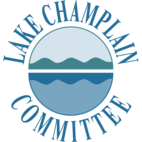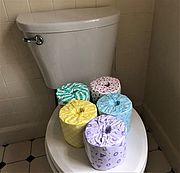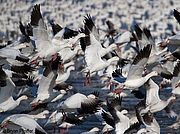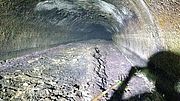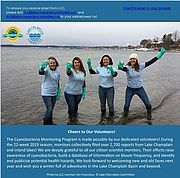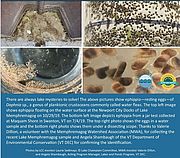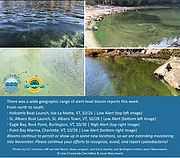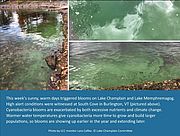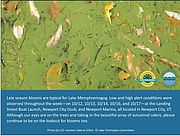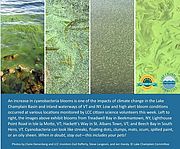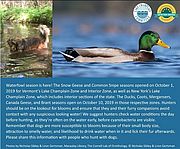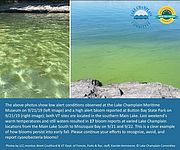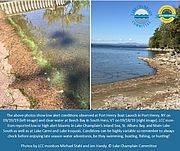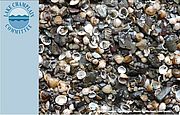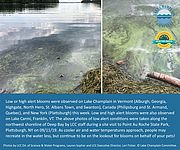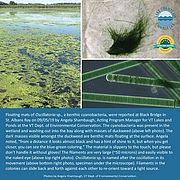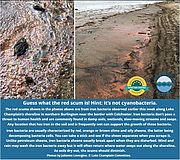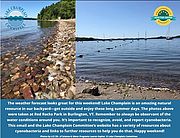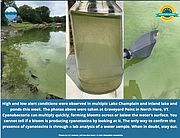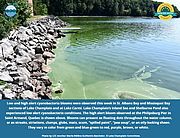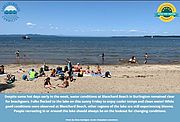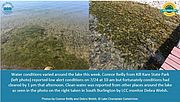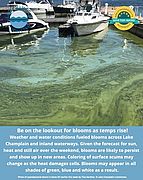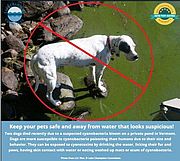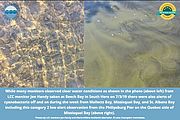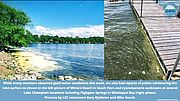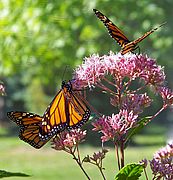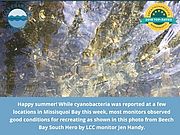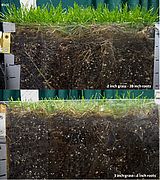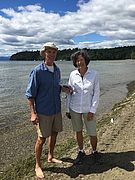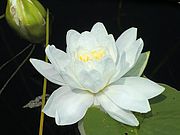Wastewater treatment and septic systems are designed to handle the four Ps—pee, poop, puke, and (toilet) paper—and nothing else. Flushing other paper products, plastics, disposable diapers, pharmaceuticals, dryer lint, condoms, tampons or applicators, or flotsam and jetsam is a big no-no. Wipes clog pipes, even if they are marketed as “flushable".
Read...News from Selected Category
This report by biologist, writer, explorer Bryan Pfeiffer provides annual breaking news on the migration of snow geese through Vermont and New York. Clinton County, New York is currently 2019’s snow goose hotspot: 8,000 snow geese were observed in King Bay, south of Rouse’s Point, on November 25. Numbers have declined in Vermont, where 106 snow geese were noted at the Dead Creek Wildlife Management Area in Addison on November 26.
Read...Fatbergs have become commonplace in city sewer systems around the world. They are an accumulation of fat, oil, and grease congealed around common household solid waste items like “flushable” wipes, paper towels, and tampons. The removal of fatbergs places a financial burden on cities.
Read...This is the last report of the 2019 Lake Champlain and Inland Lake cyanobacteria monitoring season. Lake Champlain Committee (LCC) monitors and partners have filed over 2,700 reports from Lake Champlain and inland lakes during a 22-week season. We’re deeply grateful for their efforts. Read...
It’s snowing in the Lake Champlain Valley, coating much of our region in a gentle blanket of white as we enter our last weeks of cyanobacteria monitoring. The cooler temperatures make conditions much less hospitable for cyanobacteria, so not suprisingly, the majority of reports this week were for generally safe conditions. However, the bottom-dwelling cyanobacteria, Nostoc sp., was observed again at Lake Winona earlier in the week. Read...
Cyanobacteria blooms were reported this week from Lake Champlain’s St. Albans Bay, Inland Sea, Main Lake North, Main Lake Central and Main Lake South as well as at Lake Carmi and Lake Memphremagog. Yesterday’s intense rain may wash cyanobacteria out or give them a fresh load of nutrients to grow. While the cooler temperatures will make conditions less hospitable for cyanobacteria, they may still pop up so please use the links and resources in this email to help you recognize, avoid and report blooms. Read...
Blooms were observed this week at a few Lake Champlain locations as well as on Lake Memphremagog. Temperatures are predicted to stay fairly warm into the beginning of next week, so cyanobacteria may continue to show up in waterways. As you enjoy fall’s beauty in the watershed, please keep a close eye on the water and use the information and links in this email to learn how to recognize, avoid, and report cyanobacteria. Read...
Blooms were experienced this week in Lake Champlain’s St. Albans Bay and Main Lake North, as well as Lake Carmi and Lake Memphremagog. We’ve had a blustery few days, with strong winds triggering lots of wave action on our waterways. In addition to breaking up existing surface accumulations, the windy weather and power outages also affected some monitors’ ability to report. Read...
We had some great weather for leaf peeping this week but unfortunately, those moderate temperatures and sunny, calm days also helped cyanobacteria blooms flourish. High alert or mixed conditions were witnessed in Lake Champlain’s St. Albans Bay, the Inland Sea, Malletts Bay, Main Lake North, Main Lake Central and Main Lake South as well as in Lake Carmi and Lake Memphremagog. Read...
As temperatures cool and hues of orange, yellow and red color the hillsides, we hope you are enjoying autumn’s beauty. Although blooms are less likely as air and water temperatures drop and frost warnings are in effect, cyanobacteria can still persist or pop up. While there were plenty of reports of clear water this week, blooms continued to show up in Lake Champlain and an inland waterway. Read...
Unseasonably warm weekend weather triggered a spate of 17 bloom reports on 9/21 and 9/22. More blooms followed during the week, with some monitors reporting their first blooms of 2019. With temperatures predicted to rise into the 70s on Saturday, we anticipate some blooms will continue to persist for a while and that cyanobacteria may pop up in new locations. Read...
Today marks the global climate strike followed by a week of events to highlight the urgency of climate action. Water is a primary medium through which we feel the effects of climate change. Declining water quality is another consequence of a warming planet. As air temperatures rise, so too do water temperatures. Read...
Has the invasive Asian clam made it into Lake Champlain? Join us in our surveying efforts to find out!
We are teaming up with our friends at Arrowwood Environmental and Magic Hat Brewing Company to comb Burlington area beaches for the invasive mollusk. The program includes training, field time, and lunch! It’s a great way to learn more about Asian clams, how to identify them and what we can do to keep them out of Lake Champlain. Read...
Mixed conditions were reported again this week on Lake Champlain in Missisquoi Bay, St. Albans Bay, and the Inland Sea, and also at Lake Carmi. The floating mats of the benthic cyanobacteria Oscillatoria sp. that we showed you pictures of last week were still present at Black Bridge in St. Albans Bay on 9/10/19, but to a lesser extent. Monitors also observed mixed conditions in the Main Lake North section of Lake Champlain. Read...
Kids are back at school, seasonal staff are leaving beach and park areas, and there’s a hint of fall in the air this first week of September. However, cyanobacteria can still flourish even when autumn colors begin to show on the hillsides which is why the Lake Champlain Committee Cyanobacteria Monitoring Program continues through the end of October. Read...
It was another busy week for <link about-lcc>Lake Champlain Committee (LCC) monitors with alert level conditions reported from Lake Champlain’s Missisquoi Bay, St. Albans Bay, Inland Sea, Main Lake North, Main Lake South, and South Lake. Cyanobacteria was also reported at Colchester Pond, Lake Carmi, Lake Memphremagog, Nichols Pond, and Shelburne Pond. Bulwagga Bay Beach in Moriah NY was closed on Sunday August 25 due to a bloom but has since re-opened. Read...
We hope you’ve been enjoying the cooler temperatures and lower humidity this week. Here are results from our tenth week of the Lake Champlain Committee (LCC) cyanobacteria monitoring program. You’ll find resources and links to help you identify, report and avoid cyanobacteria. We’ve also included pictures of some of the conditions observed this week along with photos of a stick test you can use to help you differentiate cyanobacteria from non-toxin producing green algae. Please continue to share these resources with others to help educate people on water issues.
Read...
Alert level conditions were reported from several Lake Champlain locations and inland lakes this week including Lake Champlain’s inland sea, St. Albans and Missisquoi Bays and at Indian Brook Reservoir, Lake Carmi and Shelburne Pond. Scattered storms are predicted for the weekend before a rise in temperatures next week so pease be on the lookout for blooms and avoid contact with anything that looks suspicious. Read...
While there were many reports of generally safe conditions this week several sections of Lake Champlain as well as some inland waterways continue to be plagued by mixed conditions. Read LCC's latest report on cyanobacteria conditions for the week of 8/4/19. Read...
Lake Champlain Committee Monitors filed 177 reports this week! Blooms appeared in four Lake Champlain regions: Missisquoi Bay, St. Albans Bay, Inland Sea, and Main Lake Central. There were also bloom conditions at Lake Carmi and Shelburne Pond. Warm weather is predicted for this weekend. Please be on the lookout for blooms and avoid contact with anything that looks suspicious.
Over 216 reports were filed this week from Lake Champlain and inland waterways. Blooms were observed in all regions of Lake Champlain, except Malletts Bay and South Lake; Lake Carmi also had reports of cyanobacteria. Sun and heat are in the forecast for Saturday—be on the lookout for blooms!
Lake Champlain Committee monitors filed over 196 reports this week for Lake Champlain and inland waterways. While there were plenty of reports of clear water, blooms proliferated in parts of Missisquoi Bay, St. Albans Bay, the Inland Sea, Main Lake Central and Main Lake South. Shelburne Pond and Lake Carmi also had reports of cyanobacteria. Several beaches were closed in both New York and Vermont.
We saw a lot of volatility in conditions this week on Lake Champlain. Heavy rains flushed things out in some areas and in others provided additional nutrients to fuel cyanobacteria growth. Blooms showed up along the New York shoreline, in St. Albans Bay, Missisquoi Bay and along the Burlington and South Burlington shorelines and at Vermont inland waterways of Bald Hill Pond and Shelburne Pond. We also received word that two dogs recently died due to ingesting cyanobacteria from a private pond in Vermont. Please remind dog owners to be vigilant about protecting their pets and keep them away from water with cyanobacteria.
We had over 150 water quality observations from Lake Champlain and inland waterway monitors this week! Most were of good conditions but cyanobacteria was reported from Lake Champlain sites in Malletts Bay, St. Albans Bay and Missisquoi Bay. You’ll find further information and links below about cyanobacteria and how to recognize and report it. We’ve also included a photo of a mystery phenomena we are trying to identify (stay tuned for results next week) and a picture of the invasive fishhook waterflea. Populations of this aggressive, predatory zooplankton have increased dramatically since they were first discovered in Lake Champlain last September.
We had reports from 135 different sites this week with low alert sitings of cyanobacteria from Lake Champlain’s Missisquoi Bay, St. Albans Bay and Knapp Pond in Cavendish, VT. High alert bloom conditions persisted at Outer Malletts Bay on June 26 and 27 and improved to low alert conditions on Friday. Happily, most other monitors reported good conditions.
This article is a continuation of the fall 2018 article on raising Monarch butterflies for the fall migration. Both articles were written by Laura Pratt, LCC’s current ECO AmeriCorps Education & Outreach Coordinator, who raised monarchs in her home last year. Monarch butterflies are important pollinators in the Lake Champlain watershed. They rely on milkweed during their caterpillar stage – a plant which is growing scarce with an increase in urbanization and pesticide use. However, you can make a difference by planting native varieties of milkweed in your garden, encouraging your town to replace lawn with pollinator gardens where possible, and even by raising monarch butterflies yourself!
Happy start of summer! Cyanobacteria monitoring got underway earlier this week, toxin testing and phytoplankton analysis at selected shoreline locations on Lake Champlain will get underway next week as well. We are excited to have such a great crew of citizen scientists assessing water conditions! Low alert conditions were observed on the eastern side of Missisquoi Bay and some cyanobacteria was seen in the water at Niquette Bay State Park this week. All other areas of Lake Champlain along with inland Vermont lakes reported good conditions. Read...
Grass is the largest irrigated crop in the United States. It covers city parks, suburban lawns, and wide-open rural fields. Unfortunately, grass can be a major source of fertilizer runoff. While the best way to slow rainwater down and allow pollutants to settle out is to plant native grasses, shrubs, and trees instead of the traditional lawn, there are still things you can do to make your lawn green, healthy, and watershed friendly.
Help assess Lake Champlain water conditions around the lake. Complete our cyanobacteria monitor interest form if you're interested in monitoring or want to attend a training session to learn more about the lake. Feel free to share this invite with other lake lovers.
Spring isn’t just a time when trees and flowers are coming alive – plants are also opening up throughout the ponds, lakes, and waterways. While aquatic plants may look similar to their land-bound counterparts, they have evolved to endure an environment where light is often scarce and concentrations of atmospheric gases are low. These adaptions are clearly displayed in the variations between aquatic leaves.
